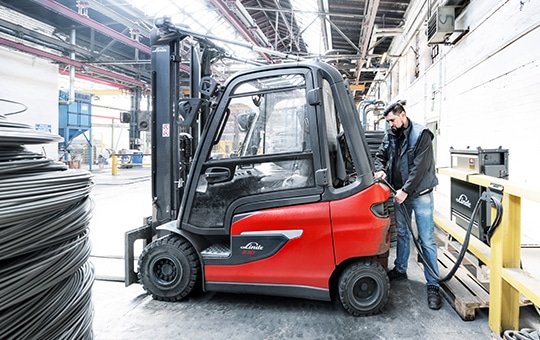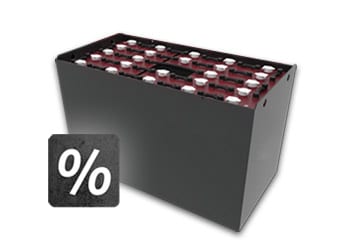Energy systems for your intralogistics
Lead-acid battery, lithium-ion technology, fuel cell or rather the classic combustion engine? If you want to work economically and efficiently, you have to find the right energy system for your company. Every company has individual requirements for the energy supply of its industrial trucks. Not every technology is suitable for every company. The decision depends on various criteria and requires a high degree of experience. As a true energy provider, GRUMA helps you find the perfect energy system for your intralogistics. We offer the latest technology for every energy system, a wide range of models and comprehensive services.

Your advantages
Holistic & individual consulting
Professional & competent contact persons
Reliable After Sales Service
Our energy systems
Your drive is our drive
We will find the right energy system for you!
When selecting the right energy system, we examine the interaction of three main components: Vehicle, drive type and energy infrastructure. The decision for or against a particular energy system depends on the individual needs of a customer. The respective area of application, costs, necessary framework conditions and the future viability of the system must be considered. When selecting the right energy system, we examine the following six criteria.

Infrastructure & Vehicle Availability
First, the current energy supply (e.g. photovoltaic systems, filling stations, etc.) in the company is considered. Depending on the energy system, special infrastructure (e.g. space for battery charging stations, larger grid power cables, open spaces for filling stations, etc.) may first have to be created or the existing one expanded.
The point of vehicle availability also plays an important role. Long downtimes due to battery changes, charging processes or maintenance work can cause failures that can be kept to a minimum by choosing the right system.
Areas of application & future viability
The locations (e.g. indoor or outdoor) and conditions (e.g. food industry, chemical industry) of the vehicles are also considered in detail. Not every drive type is suitable for every application. For example, a diesel truck is not the first choice in enclosed halls due to the exhaust gases produced.
When a company invests in a new system, it often has a specific goal. Whether it is to meet society's desire for sustainable supply chains and climate neutrality, to save energy, or to optimize the process in the warehouse. Thus, the future viability of the technology is also an important selection criterion.


Safety & cost-benefit ratio
The topic of occupational safety and thus also driver safety are becoming increasingly important. A lack of knowledge about battery replacement, acid handling and the like can lead to unsightly accidents. Accordingly, many companies rely on technologies that are fast, safe and uncomplicated to use.
In the final evaluation, the acquisition costs (e.g. commissioning, construction or adaptation of the infrastructure) and operating costs (e.g. maintenance, servicing, energy costs) are still decisive. By means of a cost-benefit comparison, we help you find the right energy system for your individual needs.
Funding opportunities for forklifts
Do you want to get rid of the combustion engine or lead-acid technology and switch to more environmentally friendly alternatives, such as lithium-ion batteries or hydrogen? Then you should definitely take a look at the federal government's subsidy programs. The German Federal Office of Economics and Export Control (BAFA) currently offers a program in the field of energy efficiency that can be used for the purchase of new industrial trucks.
Our energy consultants will be happy to inform you about the various funding options and their requirements and support you in the application process.


Holistic energy consulting
Keeping track of the multitude of factors is not easy. Our energy experts will be happy to help you find the right energy storage mix for your fleet.
We provide you with an overview of your current vehicle energy consumption and support you in considering your CO2 - consumption. Based on the energy consumption measurement, we can show you your current cost situation and CO2 consumption without obligation. This enables us to reveal potentials for new drive technologies and to derive optimization proposals for existing energy systems.

Do you still have questions?
David
Sieverdingbeck
Our energy systems in comparison

Internal combustion engines
Advantages:
- Powerful engine performance
- High load capacity up to 18 tons
- Low-noise and economical engines
- Long and intensive operations possible
- Long service intervals & easy maintenance
- Cost effective purchase
Disadvantages:
- Pollution
Areas of application:
- In outdoor use (especially diesel engines)
- In indoor use (mainly propellant gas vehicles)
- For uneven ground conditions and long, heavy operations
- In multiple shift operation

Lithium-ion batteries
Advantages:
- High vehicle availability
- Short and fast intermediate charging possible
- Long life
- High energy efficiency and high overall efficiency (30 - 50% energy cost savings compared to lead-acid batteries and combustors)
- Suitable for cold storage
- No maintenance costs & low space costs
Disadvantages:
- High acquisition costs, which are put into perspective when considering the overall costs. We would be happy to advise you on this.
Areas of application:
- In the field
- Indoor use
- In multiple shift operation
- In sensitive work areas (e.g. cold storage, pharmaceutical, beverage or food industry).

Lead-acid batteries
Advantages:
- Proven energy system
- Low acquisition costs
- Wide range of vehicles
- Easy battery change
Disadvantages:
- High maintenance
- Multi-shift operation only possible with battery change
- High demands on the charging infrastructure
Areas of application:
- Indoor use
- Light to medium and shorter operations
- Heavy duty applications possible with several exchangeable batteries

Fuel cells
Advantages:
- Very low space requirement for refueling many vehicles
- Forecast: hydrogen costs will fall over time
- No exhaust gases, no CO2
- High vehicle availability due to fast refueling
- Safe and clean handling
- Long life
- Up to 40% promotion from the state
Disadvantages:
- Regular maintenance
- High investment costs
Areas of application:
- Continuous, intensive use in multi-shift operation with a high turnover rate
Downloads
All information about the lithium-ion battery
Frequently asked questions about energy systems
All drive types still have their justification. The selection of the appropriate energy system for the future depends primarily on the area of application of the vehicles. Not every technology is suitable for every area of application. There are specific areas in which the internal combustion engine is still the most economical and technically best solution.
However, in addition to combustion engines and lead-acid batteries, more and more companies are turning to lithium-ion batteries or fuel cells. With the new drive technologies, exhaust gases are avoided and battery replacement or acid handling is no longer necessary. This in turn has a positive effect on occupational safety. As soon as customers' trucks are powered by hydrogen, the fuel cell drive will experience strong growth, as the changeover in the forklift will then take place in the same course.
Are you looking for the best system for your future? Let our energy experts advise you free of charge.
Call now: 0171/7646199
You might also be interested in

Electric forklift with the power of a combustion engine
Sustainability meets pure power: Discover our new e-truck with the performance of a combustion engine.

Suitable spare batteries for your forklift truck
Are you looking for a suitable replacement battery for your forklift? With us you are guaranteed to find the right model as well as the matching accessories.

Test energy systems by subscription now
Classic, Flex or a trial subscription? We offer a wide range of different subscription models for your electric forklift.